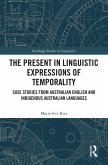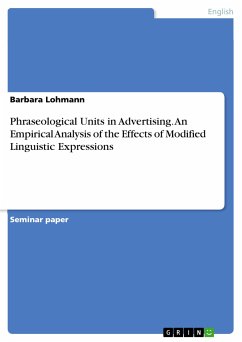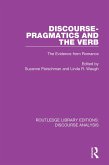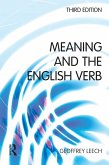The Present in Linguistic Expressions of Temporality (eBook, PDF)
Case Studies from Australian English and Indigenous Australian Languages
Sofort per Download lieferbar

The Present in Linguistic Expressions of Temporality (eBook, PDF)
Case Studies from Australian English and Indigenous Australian Languages
- Format: PDF
- Merkliste
- Auf die Merkliste
- Bewerten Bewerten
- Teilen
- Produkt teilen
- Produkterinnerung
- Produkterinnerung

Hier können Sie sich einloggen

Bitte loggen Sie sich zunächst in Ihr Kundenkonto ein oder registrieren Sie sich bei bücher.de, um das eBook-Abo tolino select nutzen zu können.
This book offers a comprehensive examination of Present Time Expressions (PTEs), illustrating how a more informed understanding of their semantic and pragmatic representations can offer unique insights into the temporal systems of languages.
The volume takes as its point of departure the notion that tenses, aspectual viewpoint markers, and temporal expressions have a semantic meaning, which is further pragmatically enriched and manipulated in use by speakers. Building on this foundation, the book introduces current theories on the linguistic expression of temporality toward better…mehr
- Geräte: PC
- mit Kopierschutz
- eBook Hilfe
![The Present in Linguistic Expressions of Temporality (eBook, ePUB) The Present in Linguistic Expressions of Temporality (eBook, ePUB)]() Marie-Eve RitzThe Present in Linguistic Expressions of Temporality (eBook, ePUB)42,95 €
Marie-Eve RitzThe Present in Linguistic Expressions of Temporality (eBook, ePUB)42,95 €![The Routledge Handbook of World Englishes (eBook, PDF) The Routledge Handbook of World Englishes (eBook, PDF)]() The Routledge Handbook of World Englishes (eBook, PDF)44,95 €
The Routledge Handbook of World Englishes (eBook, PDF)44,95 €![Phraseological Units in Advertising. An Empirical Analysis of the Effects of Modified Linguistic Expressions (eBook, PDF) Phraseological Units in Advertising. An Empirical Analysis of the Effects of Modified Linguistic Expressions (eBook, PDF)]() Barbara LohmannPhraseological Units in Advertising. An Empirical Analysis of the Effects of Modified Linguistic Expressions (eBook, PDF)15,99 €
Barbara LohmannPhraseological Units in Advertising. An Empirical Analysis of the Effects of Modified Linguistic Expressions (eBook, PDF)15,99 €![Discourse Pragmatics and the Verb (eBook, PDF) Discourse Pragmatics and the Verb (eBook, PDF)]() Discourse Pragmatics and the Verb (eBook, PDF)33,95 €
Discourse Pragmatics and the Verb (eBook, PDF)33,95 €![Meaning and the English Verb (eBook, PDF) Meaning and the English Verb (eBook, PDF)]() Geoffrey N. LeechMeaning and the English Verb (eBook, PDF)49,95 €
Geoffrey N. LeechMeaning and the English Verb (eBook, PDF)49,95 €![Issues in the Semantics and Pragmatics of Disjunction (eBook, PDF) Issues in the Semantics and Pragmatics of Disjunction (eBook, PDF)]() Mandy SimonsIssues in the Semantics and Pragmatics of Disjunction (eBook, PDF)26,95 €
Mandy SimonsIssues in the Semantics and Pragmatics of Disjunction (eBook, PDF)26,95 €![The Rhythms of English Poetry (eBook, PDF) The Rhythms of English Poetry (eBook, PDF)]() Derek AttridgeThe Rhythms of English Poetry (eBook, PDF)103,95 €
Derek AttridgeThe Rhythms of English Poetry (eBook, PDF)103,95 €-
-
-
The volume takes as its point of departure the notion that tenses, aspectual viewpoint markers, and temporal expressions have a semantic meaning, which is further pragmatically enriched and manipulated in use by speakers. Building on this foundation, the book introduces current theories on the linguistic expression of temporality toward better highlighting the need for further understanding of PTEs, encompassing tenses of the present and words such as 'now.' The volume draws on data from Australian English and Indigenous Australian languages to support its goal of arriving at a theory of the flexibility of uses of PTEs and their centrality in language and highlight the implications for future research on pragmatic and semantic change.
This book will be of particular interest to graduate students and researchers in semantics, pragmatics, discourse analysis, and philosophy of language, as well as those interested in research on Indigenous Australian Languages and Australian English.
Dieser Download kann aus rechtlichen Gründen nur mit Rechnungsadresse in A, B, BG, CY, CZ, D, DK, EW, E, FIN, F, GR, HR, H, IRL, I, LT, L, LR, M, NL, PL, P, R, S, SLO, SK ausgeliefert werden.
- Produktdetails
- Verlag: Taylor & Francis eBooks
- Seitenzahl: 260
- Erscheinungstermin: 30. November 2023
- Englisch
- ISBN-13: 9781003803126
- Artikelnr.: 69250050
- Verlag: Taylor & Francis eBooks
- Seitenzahl: 260
- Erscheinungstermin: 30. November 2023
- Englisch
- ISBN-13: 9781003803126
- Artikelnr.: 69250050
- Herstellerkennzeichnung Die Herstellerinformationen sind derzeit nicht verfügbar.
List of Figures
List of Tables
Preface
Acknowledgements
Abbreviations
Chapter 1: Introduction
1.0 Introduction: goals and motivation for the present study
1.1 Tense: an overview and brief history of the treatment of tense and of the importance of the Present
1.2 Outline of the book
Chapter 2: Tense
aspect and adverbials: overview of key semantic and pragmatic theories
2.0 Introduction
2.1 Aspect
2.1.1 Some issues with the Vendlerian categorisation
2.1.2 Aspectual composition
2.1.3 The structure of eventualities: aspectual shift and coercion
2.2 Tense and Aspect in Discourse Representation Theory
2.2.1 Temporal adverbs and adverbial phrases in DRT
2.3 The discourse-pragmatics of tense and aspect: temporal inferences of rhetorical relations
2.4 SDRT: discussion and extensions
2.5 Conclusion
Chapter 3: The temporal semantics and pragmatics of 'now' vs 'then': overview of current theories
3.0 Introduction
3.1 From now as indexical to now as anaphor
3.2 Is the sense of contrast part of the semantics of now?
3.3 Now and temporal progression
3.4 Now and then in English and cross-linguistically
3.5 'Now' and 'then' in languages other than English
3.6 Now and then: discourse marking functions
3.7 Summary and conclusions
Chapter 4 'Now' in absolute and relative uses: case studies
4.0 Introduction
4.1 Overview of 'now/then' temporal clitics in Australian Indigenous languages
4.1.1 The clitic =rru in Panyjima
4.1.2 The clitic =biyang in Jaminjung
4.1.3 The clitic =lku in Walpiri and Warlmanpa: typological considerations
4.2. The clitic =rru in Martuthunira
4.2.1 The clitic =rru and the Martuthinira TAM system
4.2.2 Detailed analysis of =rru in Martuthunira
4.2.2.1 =rru in discourse: rhetorical analysis
4.2.2.2 =rru and contrast
4.3 Discussion and conclusion
Chapter 5: Shifted tenses: the Historical Present
5.0 Introduction
5.1 Early discussion: the HP as a 'dramatic or vivid' tense and the nature of the English Simple Present
5.2 Do we need a dual context to represent the HP?
5.3 The role of tense vs aspect and discourse relations
5.4 The Present: a combination of deictic and relative meaning? The case of 'double access' sentences
5.5 The Narrative/Historical Present and perfectivity: some cross linguistic observations
5.6 Conclusions and sketch of an alternative proposal
Chapter 6: Present tenses and shifted uses in discourse: case studies
6.0 Introduction
6.1 A Narrative Future? Telling a story in Martuthunira
6.2 The Narrative Present Perfect and the Historical Present: telling a story in Australian English
6.2.1 The Narrative Present Perfect in two genres
6.2.2 The Simple Past
the Historical Present and the Narrative Present Perfect: understanding the differences
6.2.3 Pragmatic effects of shifted present tenses: vividness
evidentiality and mirativity
6.3 The shifted present domain: discussion
Chapter 7: Towards a theory of the linguistic present
7.0 Introduction
7.1 What's in a 'now'?
7.2 What's in a present?
7.3 Presentness: absolute and relative
7.4 The pretence
7.5 Conclusion
Chapter 8: What now?
8.0 Introduction
8.1 Deixis
anaphora; relative and absolute tense
8.2 Empirical testing of speakers' perceptions of 'now' and the present time
8.3 Emprical studies of figurative language use
8.4 Concluding: further research
List of Figures
List of Tables
Preface
Acknowledgements
Abbreviations
Chapter 1: Introduction
1.0 Introduction: goals and motivation for the present study
1.1 Tense: an overview and brief history of the treatment of tense and of the importance of the Present
1.2 Outline of the book
Chapter 2: Tense
aspect and adverbials: overview of key semantic and pragmatic theories
2.0 Introduction
2.1 Aspect
2.1.1 Some issues with the Vendlerian categorisation
2.1.2 Aspectual composition
2.1.3 The structure of eventualities: aspectual shift and coercion
2.2 Tense and Aspect in Discourse Representation Theory
2.2.1 Temporal adverbs and adverbial phrases in DRT
2.3 The discourse-pragmatics of tense and aspect: temporal inferences of rhetorical relations
2.4 SDRT: discussion and extensions
2.5 Conclusion
Chapter 3: The temporal semantics and pragmatics of 'now' vs 'then': overview of current theories
3.0 Introduction
3.1 From now as indexical to now as anaphor
3.2 Is the sense of contrast part of the semantics of now?
3.3 Now and temporal progression
3.4 Now and then in English and cross-linguistically
3.5 'Now' and 'then' in languages other than English
3.6 Now and then: discourse marking functions
3.7 Summary and conclusions
Chapter 4 'Now' in absolute and relative uses: case studies
4.0 Introduction
4.1 Overview of 'now/then' temporal clitics in Australian Indigenous languages
4.1.1 The clitic =rru in Panyjima
4.1.2 The clitic =biyang in Jaminjung
4.1.3 The clitic =lku in Walpiri and Warlmanpa: typological considerations
4.2. The clitic =rru in Martuthunira
4.2.1 The clitic =rru and the Martuthinira TAM system
4.2.2 Detailed analysis of =rru in Martuthunira
4.2.2.1 =rru in discourse: rhetorical analysis
4.2.2.2 =rru and contrast
4.3 Discussion and conclusion
Chapter 5: Shifted tenses: the Historical Present
5.0 Introduction
5.1 Early discussion: the HP as a 'dramatic or vivid' tense and the nature of the English Simple Present
5.2 Do we need a dual context to represent the HP?
5.3 The role of tense vs aspect and discourse relations
5.4 The Present: a combination of deictic and relative meaning? The case of 'double access' sentences
5.5 The Narrative/Historical Present and perfectivity: some cross linguistic observations
5.6 Conclusions and sketch of an alternative proposal
Chapter 6: Present tenses and shifted uses in discourse: case studies
6.0 Introduction
6.1 A Narrative Future? Telling a story in Martuthunira
6.2 The Narrative Present Perfect and the Historical Present: telling a story in Australian English
6.2.1 The Narrative Present Perfect in two genres
6.2.2 The Simple Past
the Historical Present and the Narrative Present Perfect: understanding the differences
6.2.3 Pragmatic effects of shifted present tenses: vividness
evidentiality and mirativity
6.3 The shifted present domain: discussion
Chapter 7: Towards a theory of the linguistic present
7.0 Introduction
7.1 What's in a 'now'?
7.2 What's in a present?
7.3 Presentness: absolute and relative
7.4 The pretence
7.5 Conclusion
Chapter 8: What now?
8.0 Introduction
8.1 Deixis
anaphora; relative and absolute tense
8.2 Empirical testing of speakers' perceptions of 'now' and the present time
8.3 Emprical studies of figurative language use
8.4 Concluding: further research







